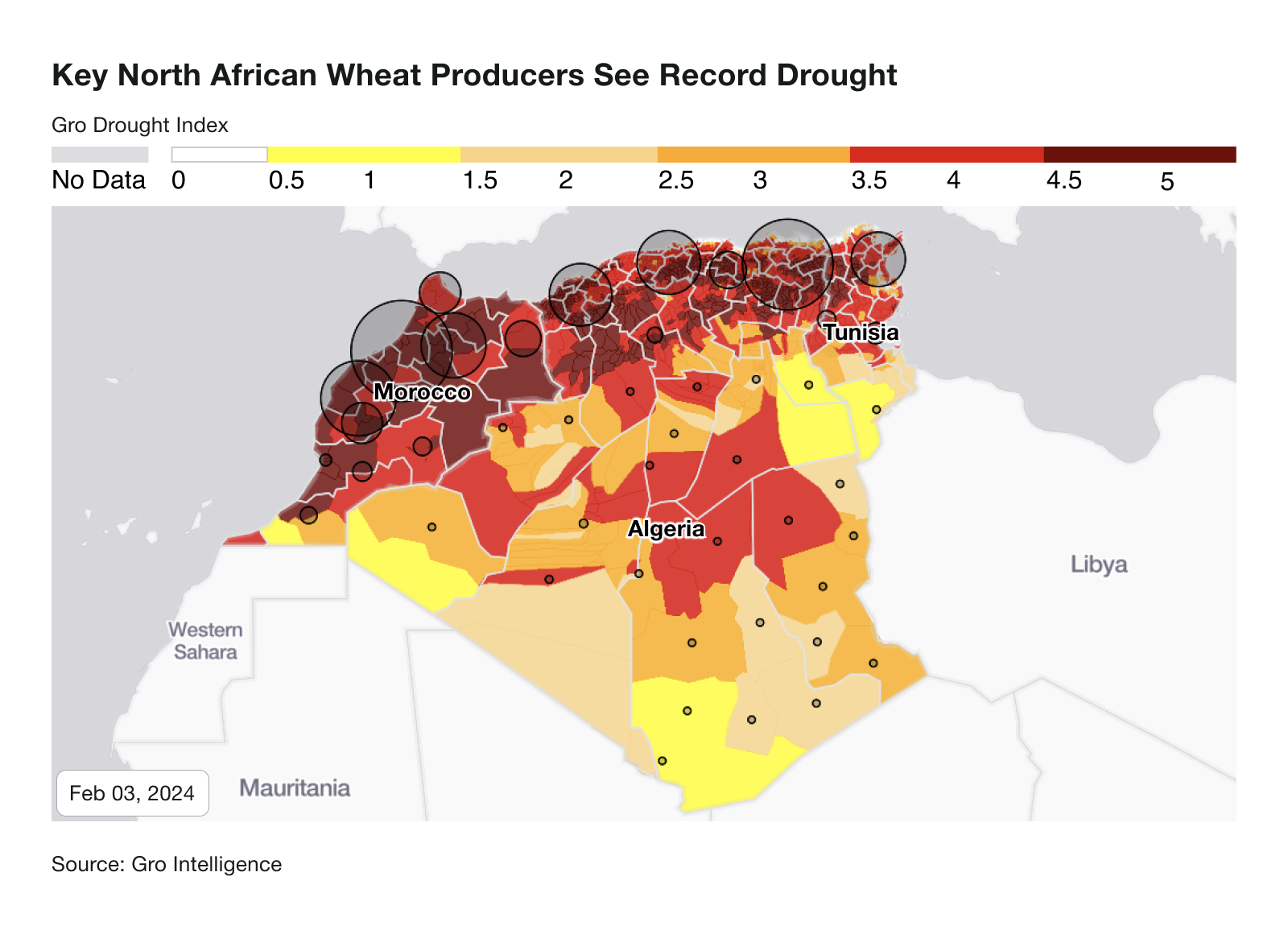Record North African Drought to Drive Wheat Imports Higher
A third consecutive year of drought conditions could push Algeria, Morocco, and Tunisia to increase their wheat imports again in 2024/25 to meet demand and bolster wheat stocks.
North Africa is the largest wheat-importing region in the world. Wheat imports to the area rose in 2023/24 to the highest level in seven years amid record-setting drought. Now, Gro’s Drought Index for the North African countries has increased further to reach the highest point for this time of year since at least 2003, as seen in this display from Gro’s Climate Risk Navigator for Agriculture.
The most recent rainy season, which typically runs from August through December, brought little relief to the region: accumulated precipitation was 50% below the 10-year average in Algeria, 55% below average in Morocco, and 63% below average in Tunisia.
While global wheat prices have been trending down since June 2022, as this Gro display shows, weakened local currencies have kept prices elevated in many import-reliant countries. For example, Egypt, normally the world’s No. 1 wheat importer, is set to import less wheat this year as prices remain stubbornly high due in part to the Egyptian pound’s slumping exchange rate, as Gro highlighted here.
Plentiful grain exports from Black Sea origins have eased some of those price pressures. In January, grain exports out of Ukraine reached levels not seen since before the war with Russia, as Gro highlighted here. Strong exports out of Russia have also helped moderate prices.
In Morocco, one of the top wheat-producing and wheat-importing countries in Africa, the dirham has been much less severely hit than the Egyptian pound — indeed, the currency is up nearly 2% in the past year, according to Gro’s Currency Browser. Still, Morocco's food prices are currently 18% higher than levels seen in 2020, when global food costs began rising, according to Gro’s Agricultural Price Inflation Application, which measures a basket of commodities in local currencies.
Morocco’s currently growing wheat crop are showing vegetative health readings that are among the lowest in the last two decades, as seen in this Navigator display. Similar conditions for this time of year were most recently seen in 2022, when Morocco’s wheat harvest plummeted to 53% below its five-year average. The country’s wheat imports climbed to 45% above average that year.
View this Gro display showing wheat production and imports for Morocco, Algeria, and Tunisia.
Meanwhile, conditions in neighboring Algeria have deteriorated from the already poor conditions seen in 2023, when the country’s wheat production fell 27% from the year before and wheat imports ticked up. With soil moisture in Algeria’s wheat-growing regions currently at the lowest level for this time of year since at least 2010, the country’s wheat imports will likely remain elevated in 2024/25.
Vegetative health in Tunisia’s wheat-growing areas has been steadily increasing since the beginning of January 2024 as a result of some rain in the region, but the Gro Drought Index remains near record highs and soil moisture continues to decline. Tunisia also saw its 2023/24 wheat imports increase from the year before as production dropped and its wheat stocks fell to the lowest level in over 10 years.

Amid the third consecutive year of drought in North Africa, the Gro Drought Index is currently flagging “extreme drought” (indicated by the red coloring in the map above) and “exceptional drought” (the index’s highest reading, indicated by the brown coloring) in wheat-growing regions (denoted by the circles) across Morocco, Tunisia, and Algeria.
 Insight
InsightPrices Surge for Cocoa, Coffee, and Other ‘Soft’ Commodities
 Blog
BlogGain Actionable Insight Into Climate Impacts With The Gro Climate Ensemble
 Insight
InsightGro’s 2024 Watchlist: 3 Forces Shaping Global Climate Risk in the Year Ahead
 Insight
Insight

 Search
Search